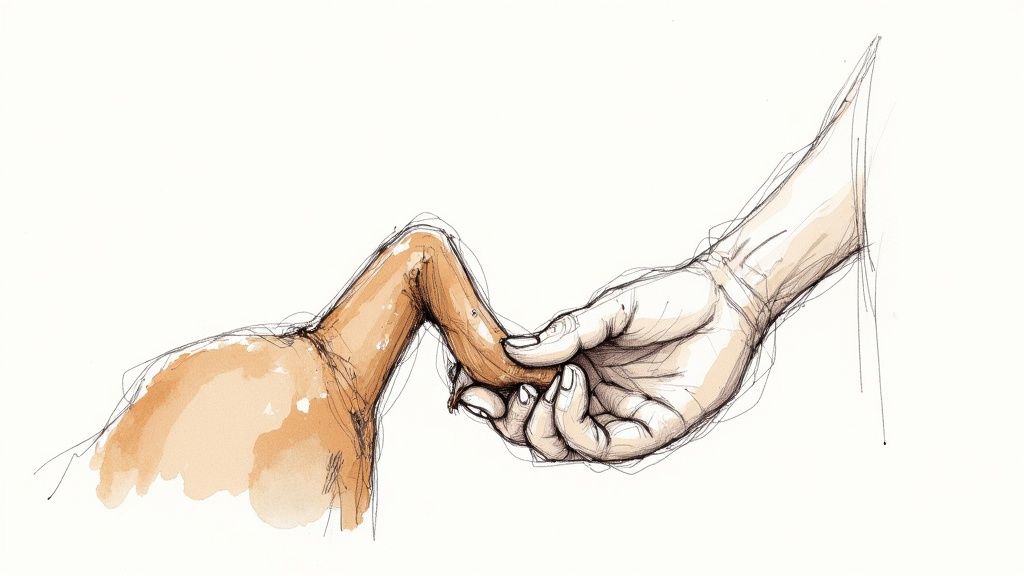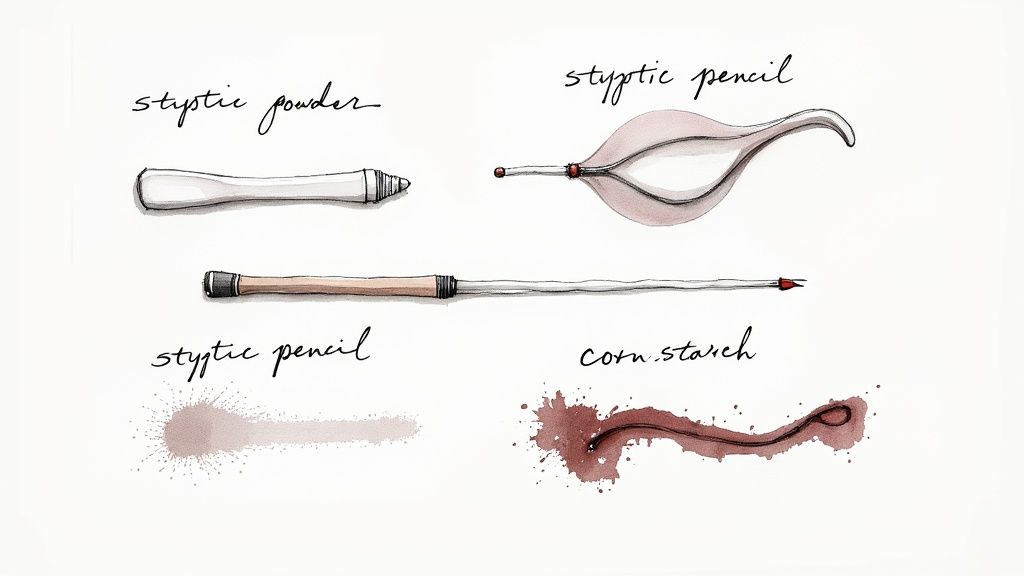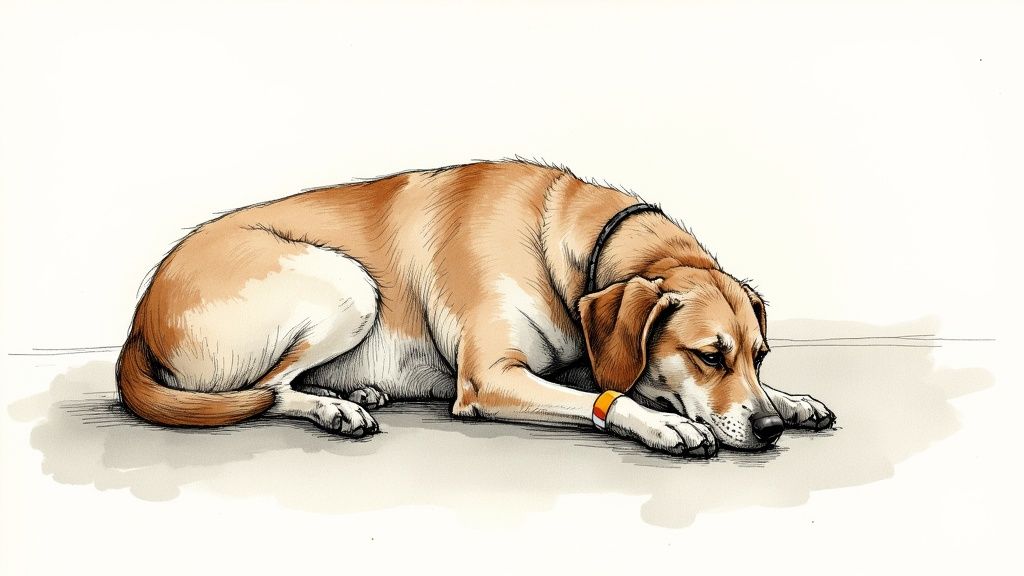Understanding Why Dog Nails Bleed: The Science Behind the Emergency

When your dog's nail starts bleeding, understanding the underlying anatomy helps explain why it happens and how to treat it effectively. The key structure involved is the quick - a pink, triangular area inside the nail that contains blood vessels and nerves, similar to the sensitive tissue under human fingernails.
The Quick and Its Role in Bleeding
The quick serves an important purpose by supplying blood and nutrients to keep the nail healthy and growing. This abundance of blood vessels is also why even minor injuries to the quick result in significant bleeding. Just like when you cut your finger while cooking, the quick bleeds easily when damaged. Most dogs react strongly to quick injuries because of the many nerve endings in this sensitive area.
How Nail Injuries Occur
Dogs can injure their nails in several common ways beyond trimming accidents. Active dogs who dig frequently or scratch at hard surfaces risk breaking or tearing their nails. Sudden trauma like catching a nail in a fence or doorway while running and playing can also cause painful tears. These injuries range from small cracks to complete nail removal.
One of the most frequent causes is accidental cuts during nail trimming when the quick is nicked. According to veterinary statistics from PetMD, nail trim injuries are among the top minor injuries that bring dogs to the vet. This highlights why proper trimming technique is essential for preventing these painful accidents.
Factors Affecting Nail Health and Healing
Several key factors influence how prone dogs are to nail injuries and how well they recover. For example, senior dogs often develop more brittle nails that split and crack more easily. Health conditions like fungal infections can weaken the nail structure over time. A dog's physical activity level also matters - those who exercise vigorously on rough terrain face higher injury risks. Understanding these variables helps owners take the right preventive steps and provide appropriate care when injuries occur.
Recognizing Signs of Nail Injury: Beyond the Obvious Bleeding

A nail injury isn't always marked by visible bleeding. Understanding the full range of warning signs helps you catch problems early and provide proper care. By paying attention to both behavior changes and physical symptoms, you can better assess your dog's condition and determine when veterinary care is needed.
Behavioral Changes: A Window into Your Dog's Pain
Dogs often show discomfort through subtle behavior shifts. A typically energetic pup may suddenly become withdrawn or hesitant to play and walk around. Many dogs will also focus intensely on the injured paw - repeatedly licking or chewing at it to soothe the pain. These behavior changes warrant a closer look at the affected area.
Physical Symptoms: More Than Just Bleeding
Watch for signs beyond bleeding that indicate nail damage. Common symptoms include limping, holding up one paw, or swelling and redness around the nail bed. These physical changes point to potential tissue injury or infection, even after bleeding stops. A thorough check of the paw is important to assess the full extent of damage.
When nails are overgrown or split, they can cause ongoing bleeding whenever your dog puts weight on the paw. Dogs may cry out in pain or show clear signs of distress. In severe cases, the nail may become avulsed (completely torn off), requiring immediate first aid like styptic powder application. Learn more about broken toenail injuries and treatment options at Embrace Pet Insurance.
Knowing When to Seek Veterinary Care
Some nail injuries need professional medical attention. Seek immediate vet care if:
- The bleeding won't stop with home first aid
- You notice signs of infection (swelling, discharge, foul smell)
- Your dog shows severe pain
- The nail is fully detached
When in doubt about injury severity, consult your veterinarian. Quick professional assessment helps prevent complications and ensures proper healing.
Mastering Emergency First Aid: Step-by-Step Crisis Management
When your dog has a nail injury, knowing how to quickly stop the bleeding can prevent complications and reduce their discomfort. By learning essential first aid techniques, you'll be better equipped to handle these stressful situations.
Immediate Steps to Control Bleeding
Quick action is important, but first take a deep breath and stay calm - your dog will pick up on your energy. Follow these key steps:
-
Apply Direct Pressure: Use a clean gauze pad or cloth and press firmly on the bleeding nail for at least 2-5 minutes straight. Don't keep checking it, as this can disrupt clot formation. Just like with a cut on your finger, steady pressure allows the blood to clot properly.
-
Elevate the Paw: When possible, hold the injured paw above heart level to reduce blood flow and help clotting.
Using Styptic Products
If pressure alone isn't stopping the bleeding, styptic agents can help by constricting blood vessels and forming clots faster:
-
Styptic Powder: Gently press the nail into the powder for complete coverage. Your dog may feel a slight sting, which is normal. Hold still for one minute.
-
Styptic Pencils: Wet the tip and apply directly to the nail. Like the powder, expect mild stinging.
Common Household Options
No styptic products on hand? These kitchen staples can work in a pinch:
-
Cornstarch or Flour: Pack a small amount onto the nail while applying pressure - these natural ingredients help blood clot.
-
Baking Soda: Mix with a little water to form a paste and apply to the nail. While not as effective as cornstarch, it can still help control bleeding.
Keeping Your Dog Calm
Most dogs get anxious during first aid. Here's how to help them stay relaxed:
- Use a gentle voice: Speak softly and calmly to reassure them
- Hold securely: Have someone help hold your dog still without using too much force
- Offer distractions: Give them a favorite toy or treat to focus on
You might be interested in: How to master...
Follow-Up Care
Once bleeding stops, keep the area clean and dry. Watch for signs of infection like swelling, redness, discharge, or bad smells. If you notice any of these symptoms or if bleeding starts again, contact your vet right away. While most nail injuries heal well with proper first aid, some may need professional care to prevent complications.
Creating a Foolproof Nail Care Routine: Prevention Strategies That Work

Good nail care goes beyond basic trimming. Just as regular dental care keeps your dog's teeth healthy, a consistent nail maintenance routine helps prevent injuries and keeps your pet comfortable. The key is understanding your dog's specific needs and making nail care a positive experience.
Choosing the Right Tools and Techniques
Quality tools are essential for safe nail care. Sharp, professional-grade nail trimmers make clean cuts that prevent splitting and cracking. Avoid using dull trimmers, as these can crush nails instead of cutting them cleanly.
Consider which trimmer style works best for you and your dog. Many owners prefer guillotine clippers for their precision, while others find scissor-style clippers give better control with thick nails. A nail grinder can be an excellent alternative for anxious dogs since it gradually files the nail rather than cutting it.
Establishing a Regular Trimming Schedule
The best way to prevent bleeding and injuries is maintaining proper nail length through regular trims. How often you trim depends on your individual dog - some need weekly maintenance while others do fine with monthly trims. Your dog's activity level and nail growth rate will guide the schedule. Get more tips in our guide on How to master....
To prevent nail bleeding, always use sharp trimmers designed specifically for pets and take off small amounts at a time. This is especially critical with black nails where the quick is hard to see. For more details on preventing bleeding, check out this helpful resource here.
Creating a Positive Nail Care Experience
Make nail trimming pleasant for your dog by introducing the process gradually. Start by getting them comfortable with having their paws handled. Reward calm behavior with treats and praise during handling and trimming sessions.
Use positive reinforcement by pairing nail care with good things. For example, give treats when showing the clippers or during brief nail handling. Building these positive associations takes time but makes future trimming sessions much easier.
Beyond Trimming: Supporting Overall Nail Health
A complete nail care approach includes natural wear activities. Regular walks on concrete or pavement help file nails naturally. Creating a designated digging area in your yard lets your dog follow natural instincts while wearing down their nails.
Good nutrition also plays a key role in nail health. A balanced diet with the right vitamins and minerals helps grow strong, resilient nails that resist splitting and cracking. By combining regular trimming with natural activities and proper nutrition, you can maintain healthy nails and reduce injury risks.
When Professional Care Becomes Critical: Making the Right Call
When your dog's nail starts bleeding, knowing whether to treat it at home or seek veterinary help can be a challenging decision. Clear guidance about when professional care becomes necessary helps ensure your pet gets the right treatment at the right time. Understanding injury types, warning signs, and proper preparation for vet visits empowers you to make informed choices about your dog's care.
Recognizing Warning Signs
While basic first aid often handles minor nail bleeding, some situations require immediate veterinary attention. If bleeding continues for more than 10 minutes despite applying pressure and styptic powder, contact your vet right away. Extended bleeding may signal a deeper injury needing professional care. Watch closely for signs of infection - swelling, discharge, unusual odors, or increasing pain mean it's time for a vet visit. Just as human wounds can become infected without proper care, dog nail injuries need careful monitoring.
Implications of Different Injury Types
The nature of the nail injury helps determine whether veterinary care is needed. Small nicks to the quick typically respond well to home treatment. However, a completely torn nail exposes sensitive tissue and bone, creating high infection risk and significant pain. These cases need professional care to manage pain, prevent infection, and ensure proper healing. Similarly, lengthwise nail cracks often require veterinary expertise since they can be more complex than clean breaks.
Preparing for the Vet Visit
If your dog needs veterinary care for a nail injury, proper preparation helps things go smoothly. Have clean towels or gauze ready to control bleeding during transport. Keep your pet calm and prevent wound licking. Make note of important details like how the injury occurred and what first aid steps you've taken. This information helps your vet quickly assess the situation and develop the right treatment plan.
What to Expect at the Vet and During Recovery
During the visit, your vet will examine the nail, clean the wound, and determine appropriate treatment. This may include trimming damaged nail portions, bandaging, antibiotics for infection prevention, or pain medication. Follow all aftercare instructions carefully - keep bandages clean and dry, and prevent your dog from disturbing the injury. Most nail injuries heal fully within a few weeks with proper care and attention. Your vet will guide you through the recovery process to help your dog return to normal activities comfortably.
Building Your Pet First Aid Arsenal: Essential Supplies and Organization

Every pet owner needs a well-stocked first aid kit to handle emergencies like nail bleeding and other accidents. Quick access to the right supplies can make a real difference when your pet needs immediate care. Setting up a complete kit is straightforward - it just takes some planning and regular maintenance. Let's look at how to build a first aid kit that helps you respond confidently to pet emergencies.
Must-Have Supplies for Nail Bleeding
When dealing with a bleeding nail, you'll need specific items to stop the bleeding and support healing. Here are the essentials:
- Styptic Powder or Pencil: These products quickly stop bleeding by constricting blood vessels. The powder form works especially well for nail injuries.
- Gauze Pads or Clean Cloth: These are needed to apply direct pressure and help form blood clots.
- Antiseptic Solution: Use a pet-safe option to clean the area and prevent infection.
- Bandaging Materials: Keep gauze rolls, cohesive bandage, and medical tape on hand to protect the nail after treatment.
Expanding Your Kit: Beyond Nail Care
While nail care supplies are important, your pet first aid kit should be ready for other emergencies too. Include these items:
- Tweezers: Perfect for removing splinters, thorns, or debris from your pet's fur or skin.
- Scissors: Get rounded-tip scissors to safely cut bandages or trim fur around wounds.
- Thermometer: Helps you check your dog's temperature when needed.
- Hydrogen Peroxide (3% Solution): Can induce vomiting if needed, but only use under veterinary guidance.
- Emergency Contact List: Write down numbers for your vet, nearest emergency clinic, and poison control.
Organizing Your First Aid Kit
Good organization helps you find what you need quickly during stressful moments. Follow these tips:
- Use a Durable Container: Choose a waterproof box or dedicated first aid bag that's clearly marked.
- Categorize Supplies: Group similar items together and use small bags to keep categories organized.
- Create a Checklist: Keep an inventory list in the kit and check it monthly to replace used or expired items.
- Store Properly: Keep the kit where all family members can find it, but out of your pet's reach.
A well-prepared first aid kit, like those recommended by Belle and Cooper, gives you the tools and confidence to handle pet emergencies effectively. By taking time to gather and organize these supplies now, you'll be ready to provide quick care when your pet needs it most. This preparation can make a real difference in keeping your pet safe and comfortable during emergencies.
Article created using Outrank

